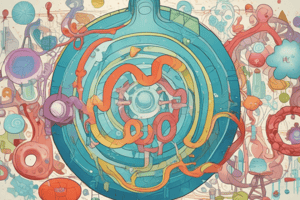Podcast
Questions and Answers
Which process involves the conversion of ammonium ion to urea in most mammals?
Which process involves the conversion of ammonium ion to urea in most mammals?
- Protein degradation
- Protein synthesis
- Protein turnover
- Amino acid catabolism (correct)
What is the fate of excess amino acids in the body?
What is the fate of excess amino acids in the body?
- Converted to glucose
- Stored for future use
- Converted to fatty acids
- Used for fuel (correct)
How are surplus amino acids utilized in the body?
How are surplus amino acids utilized in the body?
- Converted to triglycerides
- Stored in adipose tissue
- Converted to glycogen
- Used for energy production (correct)
What is the primary fate of the nitrogen in amino acids?
What is the primary fate of the nitrogen in amino acids?
Which process involves the labeling of proteins with ubiquitin for degradation?
Which process involves the labeling of proteins with ubiquitin for degradation?
Study Notes
Nitrogen Metabolism
- The urea cycle, also known as the ornithine cycle, is the process that involves the conversion of ammonium ion to urea in most mammals.
Amino Acid Fate
- Excess amino acids in the body are deaminated, resulting in the removal of their amino group (-NH2) and subsequent conversion into carbohydrates or fats.
- Surplus amino acids are utilized in the body by being broken down into carbon skeletons, which can be used for energy production or stored as glycogen or fat.
Nitrogen Fate
- The primary fate of the nitrogen in amino acids is excretion in the form of urea, which is produced in the liver through the urea cycle.
Protein Degradation
- The process of ubiquitination involves the labeling of proteins with ubiquitin, marking them for degradation by the proteasome.
Studying That Suits You
Use AI to generate personalized quizzes and flashcards to suit your learning preferences.
Description
Test your knowledge of protein turnover, amino acid catabolism, and nitrogen removal in this quiz. Learn about the regulation of protein degradation and the conversion of ammonium ion to urea in mammals.





